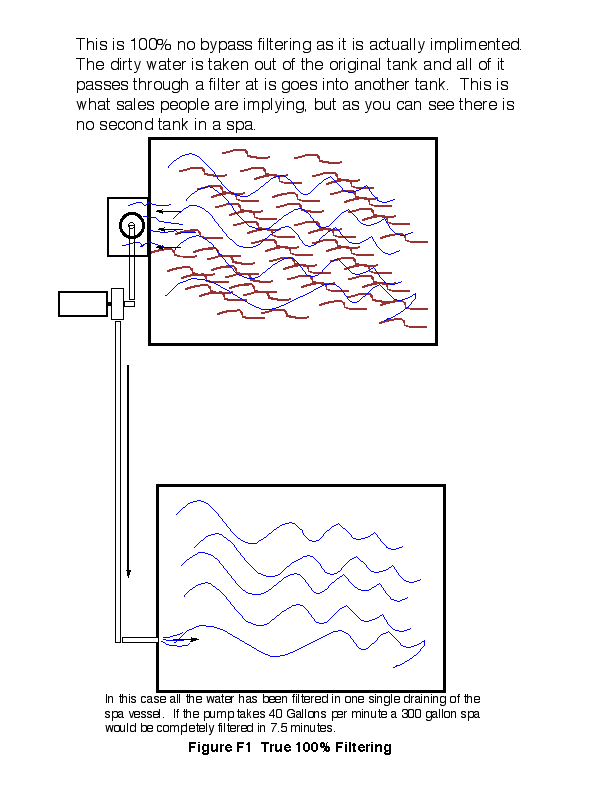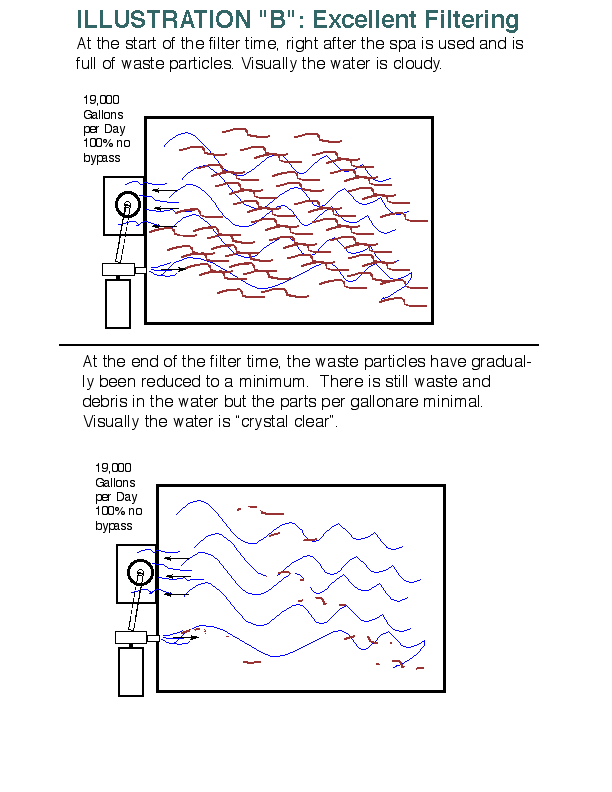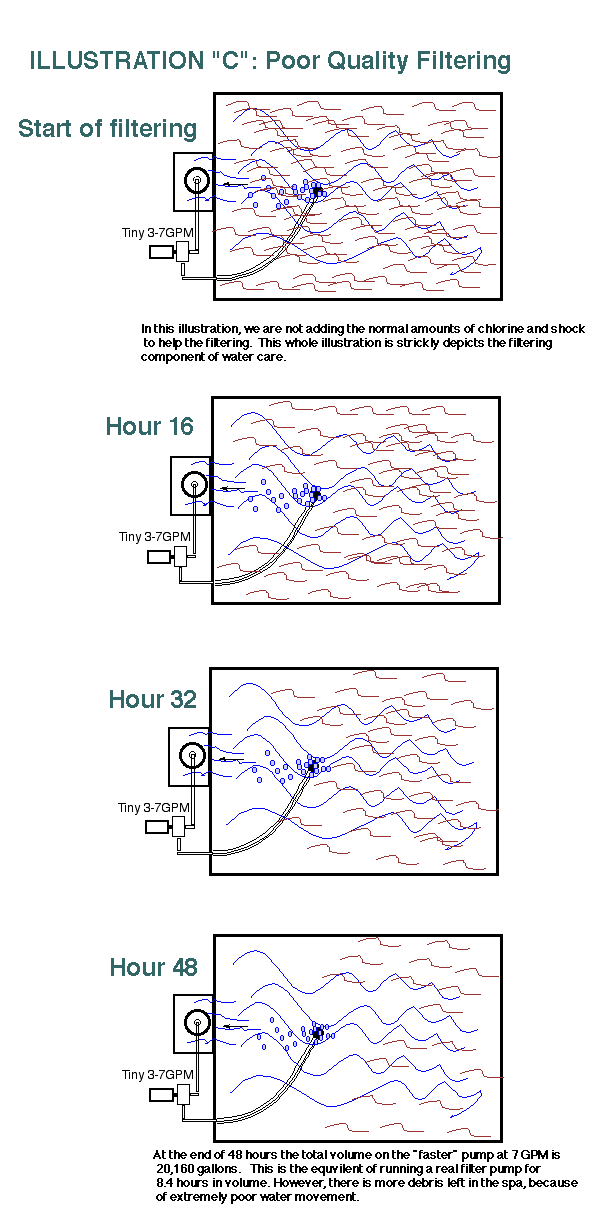
The reality is very different that what is being implied. The above illustration never happens.
The term "100% Filtering"
When customers come into our store and are regular shoppers with no spa experience, they have no idea what it is they are buying. They are literally at the mercy of sales scripts that are designed to move products, not to educate the consumer.
I have asked many of them: " How much do you know about spas?"; and the answer is usually: "Not much.".
When some
sales guy tells a shopper that their spas have 100%
filtering and that it is the best, when it is actually a
very poor design, the shoppers do not have a chance at
getting proper advice from the sales person. The spa sales
person, who by the way, is just as ignorant about spas
as the shopper, in most cases. Sales people are not normally
engineers or scientists. They are just clearly reading a
script they memorized.
When the
sales pitch implies that a spa with a no bypass filtering
system works better than a filter design with a lot more
water moving into the filter and a lot more agitation, that
is a savvy sales technique. It is "word smithing" to the
highest degree of the art of making a poor design sound
good. In sales the norm is if you have a weakness you
know is a flaw, you must still make it sound good if you
want to pay your house rent or mortgage. This is just
how it is in a money driven society for the most part.
A "no bypass" filtering system means that the end of the
pipe leading to the inlet on the pump has a filter on it and
only a filter on it and in the case of today's spas it
may haver two filters on it. That means that all the
water entering the pump is going through a filter.
There is
nothing wrong with this concept, except that the company
that uses it, is not following any engineering standards for
the size of the filters in relation to the size of the
pumps. The pumps in this brand of hot tub, can easily
overdraw the filter, causing way too much vacuum on the
suction side of the pump. The way to compensate for
that is to put too large of a motor on the pump, because if
they used the correct size that other companies use, the
motors would quickly burn out.
(Now in
2005 forward they started putting high flow screens in
the filter housing so they can further violate the ANSI and
UL by having a super high volume pass through one area of
the tub. They did this because the competition make better
therapy machines with high HP and normal ANSI engineered
bypass filtering. The largest spa company has used
this sales pitch for too long. So, they have all their
sales people believing this sales pitch. If they
changed the design, the sales pitch would not work any more.
They would, thus, be admitting that for 40 years they have
been lying.)
They
imply to people who don't know anything about spa filtering,
victimizing their own customers, that "all the water
is filtered all the time." That is a direct quote from
advertising. It does not work the way
advertising people make it out to sound. The only way to
filter all the water all the time is not available on this
planet. You cannot instantaneously have all the water in the
filter. It is an unethical approach to a relationship
with other humans.
THE
REALITY OF FILTERING
The reality on how ALL filtering works is that it is a progressive reduction of particles of debris over a period of time. It involves both drawing in the water, passing it through a filter, then spraying it out and mixing the filtered water with the dirty water. With each passage through the filter, the particles gradually collect on the filter fiber. The filters extract debris, but the filtered water is then sprayed back into the dirty water. This is similar to having a bucket of dirty water scoop out a cup of dirty water and you pour in a cup of clean water. Very gradually by this process the water become clear. That is why over 10,000 gallons of water needs to pass through the filter in a 250 gallon spa in order to remove enough debris to have real water clarity.
The other part of the equation is the nominal size of the particles being captured. The smallest being 10 microns and the largest 50 microns. This is designed to take out pretty much all the visible debris. The rest has to be taken care of by chemicals that destroy organic compounds. If you have poor filtering as in the series of tiny circ drawings below, you will use more chemicals or ozone to remove organic compounds. If the filtering is inadequate, then use more chemicals to make up for it.
In other
words, the filtering is limited by the size of the porosity
of the fiber. It's also limited by the amount of water
passing through the filter each day and the degree of
agitation. It does not matter so much if it is a
"bypass system" or a "no bypass" system as long as over
10,000 gallons pass through the actual filter fiber in the
cartridge daily. If the spa is used more you need
more filtering. Filtering capacity is totally
determined by the amount of debris per gallon of water.
More use = more filtering. (That is why we
recommend more filtering, instead of less, because Haven
spas are used almost every day by our customers for stress
and pain reduction. These are real therapy pumps.)
Here is a drawing depicting exactly what I was explaining on
the progressive reduction of particles. The top is before
filtering and the bottom is after 8 hours. This
is using a much larger pump and moving 40 GPM (gallons per
minute) or 2400 GPH (gallons per hour) for 8 hours for
a total of 19,200 gallons per day. This is very
effective filtering because the water is actually forced to
move by the strength of the jets. This makes the
debris reach the filter and be taken out of the vessel.
These illustrations only depict filtering of debris
and do not allow for any ozone, chlorine, bromine or shock.
 |
Once again it doesn't matter if there is bypass or not. It matters how the water is filtered. To imply that all the water is filtered in a tiny percent bypass system is wrong! In order to have filtering you need agitation, water movement, and gallons per hour passing through the filter media that is equal to or greater than the volume of the spa.
All the water is filtered the same in a bypass system where 19,000 gallons pass through the filter, compared to a no bypass filtering system that filters 19,000 passing through the filter. The filtering is the same.
It is the water that passes through the filter that counts and if the water is agitated enough to push the debris from all corners of the spa into the filter.
Consider the following drawings depicting my experience with the tiny circulation pump (actual testing on this companies products). There is an outlet at the bottom of the tub that bubbles up a little water at a time. In this "no bypass" system a lot of water gets "bypassed" because it stays for a long time in the extremely slow moving areas. In this method the water near the filter and towards the filter is where the bubbles are heading.
There is no propulsion of a water jet to make the water churn and get the debris on the back side and back corners.
My
experience is when you leave the spa to run on the tiny circ
pump it takes many days for all the water to make it to the
filter, if you don't supplement the filtering with a jet
pump. I did this test several times with a spa used with
only two people. After four days the water started to clear
up. It had proper amounts of sanitizer so that that was not
part of the experiment.
When I hear the sales pitch coming out of a sales person's mouth about 100% filtering all the time, it really makes me wonder about the ethics or intelligence of the company who would be telling people such nonsense. Most large spas using the tiny "5000" pump illustration below are way under filtered if the spa is used by two people daily and the customer do complain about it. This illustration shows that it takes two days to get the same amount of filtering as in the properly designed illustration above.
These
drawings are based upon two days of filtering with the tiny
pump only. The top drawing is the beginning of the time
period, right after the jet pumps turn off on a spa that is
used by four people. The last drawing is the finish of 48
hours.

The most common complaint with this type of filtering is the scum on the walls and the amounts of chemicals needed to get clarity. A spa that filters better, uses less carcinogens to keep the water clear. In the Haven Spas we focus on superior filtering and our spas use less chemicals. What you don't filter out, you have to burn out with harsh chemicals.
The area on the opposite side away from the filter is the dirty area of these spas. This is the 100% no by pass filter system that is touted as being the "best", when the reality is that it is one of the poorest filtering methods, for both ozone and for filtering, because of the low total number of gallons passing through the filter and the poor agitation that does not bring larger particles to the filter. These spa owners have only one solution to the poor filtering: More chemicals and stronger ozone.
You will also notice that the area away from the filter is much dirtier than the area directly in front of the filter. That area receives almost no agitation. These are often referred to as "dead spots".
A filter system that relies mostly on a tiny circulation pump is not only a bad design that doesn't follow the ANSI minimum standards for clean water, it is disgusting to think about all the particles that are too small to see. This method of "Filtering all the water all the time" is not even a real concept. The total number of gallons per day is about 5,000 to 9,000 gallons compared to 19,000 in 8 hours in the second illustration "B", And because of the dead spots, where water never reaches the filter, the 100% part of the sales pitch is ridiculous.. You need movement in the water to have proper filtering. To have movement you need a forceful amount of water pressure that stirs the water in the spa vessel.
What is "Bypass Filtering"
To put it simply bypass filtering is doing filtering on a jet pump according to what the ANSI standard requires.
8.2.3 " A minimum of (1) suction outlet and (1) skimmer shall be provided for each filtration system"
According to the ANSI a spa with no bypass filtering, on a high powered jet pump, is not safe. Because the whole purpose of the ANSI standard is safety. I do not make safety rules, I just try to follow them as closely as possible. Read the ANSI article Click Here And the other ANSI article
According to the Filter Manufacturers, the most flow that a real cartridge filter can have on a suction side with no bypass is configured by this rule of design: for every square foot of filter fiber you can allow .75 gallons per minute of water flow. So a 60 square foot filter that is used on 100% no bypass is allowed to have 45 Gallons per minute of flow "for the sake of sanity" and not having to put in a larger motor to compensate for the extreme restriction on the suction side of the pump.
Actually this rule is for a bypass system when you calculate the flow from the two separate areas of inlet. You are supposed to have a skimmer and a suction outlet. The way that many modern spas take care of this problem is to use a spring check valve to accommodate more flow through the filter on low speed and less on high speed.
The water is allowed to flow into the pump with the least restrictions possible. Some filter manufacturers will place the check valve at the bottom of the filter and then they attach the second suction pipe to that check valve. As the water is drawn into the pump on low speed the check valve is closed and it is nearly 100% no bypass. As the filters get dirty, the valve will open and prevent "cavitation". When the jet are turned on high speed the valve open up fully so that both areas of inlet are allowed to draw water simultaneously. The filter will not cause cavitation or a shortened life on the pump's motor, because it is not blocking the suction inlet by itself. As soon as the water draw exceeds the filter capacity, the valve opens to reduce the vacuum.
The filter will still be filtering 100% at the maximum rate of water flow the filter can take. All the water passing the filter is filtered.
In a Brand X spa the water is forced to pass through the filter and that amount of water is limited to about 60 Gallons per minute plus or minus 20 GPM depending on the condition of the filters.
In a Haven Springville model, for instance, the filters can filter from 100 to 200 Gallons per minute on high speed and 30 to 50 gallons per minute on low speed plus or minus a few GPM.. The 100% no bypass spas from H#t $pr$ng cannot even have a 200 GPM pump installed, because of the tremendous restrictions caused by the filters. If you look at their spas, they have minimal features at all and weak jet pressure. They literally split the spas in to 1/3 of a spa with three way diverter valves. How cheap is that?.
Why pay money for inferior products because you don't understand or
have never been taught or even thought about this before?
If the cost to manufacturer is far less for this 100% no bypass design why pay more for it?
Copyright Havenmade 2003-2016